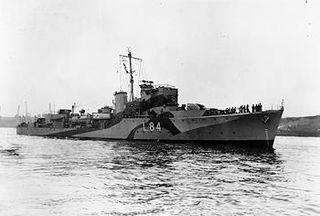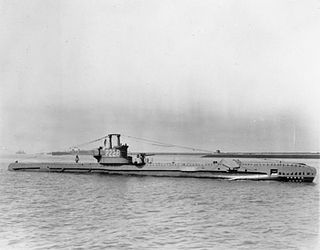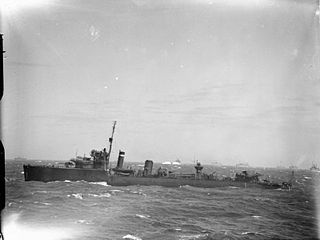
HMS Griffin (H31) was a G-class destroyer, built for the Royal Navy in the mid-1930s. In World War II she took part in the Norwegian Campaign of April–May 1940 and the Battle of Dakar in September before being transferred to the Mediterranean Fleet in November. She generally escorted larger ships of the Mediterranean Fleet as they protected convoys against attacks from the Italian Fleet. Griffin took part in the Battle of Cape Matapan in March 1941 and the evacuations of Greece and Crete in April–May 1941. In June she took part in the Syria-Lebanon Campaign and was escorting convoys and the larger ships of the Mediterranean Fleet until she was transferred to the Eastern Fleet in March 1942.

HMS Hesperus was an H-class destroyer that had originally been ordered by the Brazilian Navy with the name Juruena in the late 1930s, but was purchased by the Royal Navy after the beginning of World War II in September 1939, commissioned in 1940 as HMS Hearty and then quickly renamed as Hesperus.

HMS Zulu was a Tribal-class destroyer of the Royal Navy and the second ship to bear the name. Built in Glasgow by Alexander Stephen and Sons, her keel was laid down on 10 August 1936, she was launched on 23 September 1937 and commissioned on 7 September 1938.

The G- and H-class destroyers were a group of 18 destroyers built for the Royal Navy during the 1930s. Six additional ships being built for the Brazilian Navy when World War II began in 1939 were purchased by the British and named the Havant class. The design was a major export success with other ships built for the Argentine and Royal Hellenic Navies. They were assigned to the Mediterranean Fleet upon completion and enforced the Non-Intervention Agreement during the Spanish Civil War of 1936–1939.

HMS Hursley was a Second World War Type II Hunt-class escort destroyer of the British Royal Navy. She is the only Royal Navy ship to have carried this name. Hursley is a village in Hampshire. Commissioned in 1942, she served in the Mediterranean, before being transferred to the Hellenic Navy in November 1943 and renamed Kriti. She took part in the landings in Sicily, Anzio, and southern France, and remained in Greek service until 1959.

HMS Safari was a third batch S-class submarine built for the Royal Navy during World War II. Commissioned in 1942, she was assigned to operate in the Mediterranean Sea. During the course of the war, Safari sank twenty-five ships, most of which were Italian.

Vasilissa Olga was the second and last destroyer of her class built for the Royal Hellenic Navy in Great Britain before the Second World War. She participated in the Greco-Italian War in 1940–1941, escorting convoys and unsuccessfully attacking Italian shipping in the Adriatic Sea. After the German invasion of Greece in April 1941, the ship escorted convoys between Egypt and Greece until she evacuated part of the government to Crete later that month and then to Egypt in May. After the Greek surrender on 1 June, Vasilissa Olga served with British forces for the rest of her career.

HMS Splendid was a third-batch S-class submarine built for the Royal Navy during World War II. She was laid down on 7 March 1941 and launched on 19 January 1942. After an initial patrol through the Bay of Biscay to Gibraltar, Splendid conducted two patrols in the Mediterranean Sea; one was abandoned after technical problems and on the other she sank two Italian ships. On her next patrol, the submarine attacked two Italian convoys, sinking an Italian destroyer in the second attack. Based in Algiers, the boat operated north of Sicily, sinking six Italian ships, including two tankers and two heavy merchant ships. Splendid was detected by a German destroyer on 21 April 1943 while patrolling off Naples, Italy; the submarine was attacked with depth charges by the destroyer and forced to surface, after which she was scuttled and her surviving crew members taken prisoner. She was the most successful British submarine by tonnage sunk between November 1942 and May 1943.

HMS Torbay (N79) was a T-class submarine of the Royal Navy. She was laid down at Chatham Dockyard and launched on 9 April 1940.

HMS Laforey was an L-class destroyer of the Royal Navy. She was commissioned in and served during the Second World War, and was torpedoed and sunk by a U-boat in 1944. She had been adopted by the civil community of Northampton in November 1941.
HMS Marigold was a Flower-class corvette of the Royal Navy. She was launched on 4 September 1940 and was sunk by an Italian air-dropped torpedo on 9 December 1942.

HMS Westcott (D47) was a Royal Navy Admiralty W-class destroyer that served in the Second World War. In the Second World War Westcott served in an anti-submarine role and escorted numerous Atlantic and Malta convoys.

HMS Blankney was a Hunt-class destroyer of the Royal Navy and was the first and so far only warship to bear the Name. She was laid down on 17 May 1940 at John Brown & Company, Clydebank, Scotland, launched on 19 December 1940 and commissioned on 11 April 1941.
HMS Blencathra (L24) was a Hunt-class destroyer of the Royal Navy in commission from 1940 to 1948. She was a member of the first subgroup of the class, and saw service through most of World War II.

The second HMS Exmoor (L08), ex-HMS Burton, was a Hunt-class destroyer of the Royal Navy in commission from 1941 to 1945. She was a member of the second subgroup of the class, and saw service during much of World War II. She later served in the Royal Danish Navy as HDMS Valdemar Sejr.

HMS Wishart (D67) was a Modified W-class destroyer of the British Royal Navy that saw service in World War II. She spent most of her wartime career based at Gibraltar, engaged in convoy defence, but also served in various naval and military operations in the Mediterranean Sea.

HMS Walker (D27) was a W-class destroyer of the British Royal Navy that saw service in the final months of World War I, in the Russian Civil War and in World War II.

HMS Whitehall, pennant number D94, later I94, was a Modified W-class destroyer of the British Royal Navy that saw service in the Second World War.

HMS Douglas was an Admiralty type flotilla leader of the British Royal Navy. Built by Cammell Laird, Douglas commissioned in 1918, just before the end of the First World War. During the Second World War, Douglas served with Force H out of Gibraltar and as a convoy escort. She was sold for scrap in March 1945.

HMS Easton was a Type III Hunt-class destroyer of the British Royal Navy. Easton was built by the shipbuilder J Samuel White in 1941–1942, being launched on 11 July 1942 and completed on 7 December 1942.


















